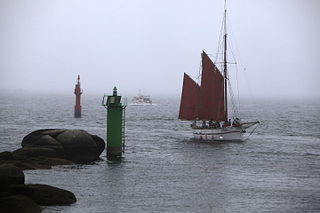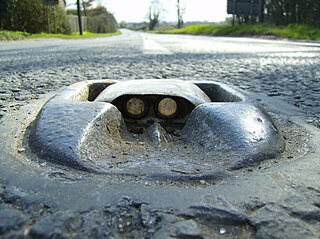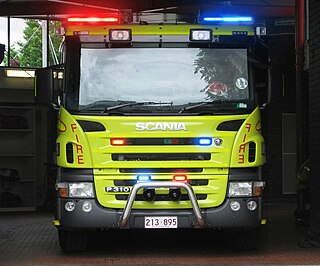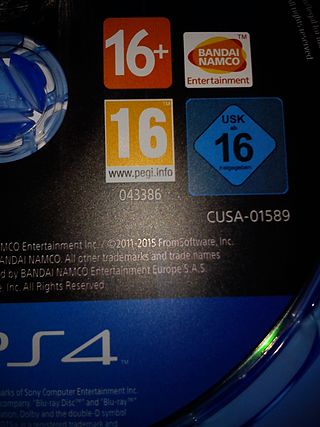Related Research Articles

Traffic lights, traffic signals, or stoplights – also known as robots in South Africa – are signalling devices positioned at road intersections, pedestrian crossings, and other locations in order to control flows of traffic.

A sea mark, also seamark and navigation mark, is a form of aid to navigation and pilotage that identifies the approximate position of a maritime channel, hazard, or administrative area to allow boats, ships, and seaplanes to navigate safely.

A cat's eye or road stud is a retroreflective safety device used in road marking and was the first of a range of raised pavement markers.

A navigation light, also known as a running or position light, is a source of illumination on a watercraft, aircraft or spacecraft, meant to give information on the craft's position, heading, or status. Some navigation lights are colour-coded red and green to aid traffic control by identifying the craft's orientation. Their placement is mandated by international conventions or civil authorities such as the International Maritime Organization (IMO).

PEGI or Pan-European Game Information is a European video game content rating system established to help European consumers make informed decisions when buying video games or apps through the use of age recommendations and content descriptors. It was developed by the Interactive Software Federation of Europe (ISFE) and came into use in April 2003, replacing many national age rating systems with a single European system. The PEGI system is now used in 41 countries and is based on a code of conduct, a set of rules to which every publisher using the PEGI system is contractually committed. PEGI self-regulation is composed by five age categories and nine content descriptors that advise the suitability of a game for a certain age range based on the game's content. The age rating is not intended to indicate the difficulty of the game or the skill required to play it.

A motor vehicle has lighting and signaling devices mounted to or integrated into its front, rear, sides, and, in some cases, top. The devices illuminate the road ahead for the driver and increase the vehicle's visibility, allowing other drivers and pedestrians to see its presence, position, size, direction of travel, and its driver's intentions.

Emergency vehicle lighting, also known as simply emergency lighting or emergency lights, is a type of vehicle lighting used to visually announce a vehicle's presence to other road users. A sub-type of emergency vehicle equipment, emergency vehicle lighting is generally used by emergency vehicles and other authorized vehicles in a variety of colors.
Australian railway signalling varies between the States of Australia, because the individual States are were responsible for the railway systems within their own borders, with, historically, no need to co-ordinate between states except at the boundaries.

A tell-tale, sometimes called an idiot light or warning light, is an indicator of malfunction or operation of a system, indicated by a binary (on/off) illuminated light, symbol or text legend.

In traffic engineering, there are regional and national variations in traffic light operation. This may be in the standard traffic light sequence or by the use of special signals.

A navigational aid (NAVAID), also known as aid to navigation (ATON), is any sort of signal, markers or guidance equipment which aids the traveler in navigation, usually nautical or aviation travel. Common types of such aids include lighthouses, buoys, fog signals, and day beacons.

A video game content rating system is a system used for the classification of video games based on suitability for target audiences. Most of these systems are associated with and/or sponsored by a government, and are sometimes part of the local motion picture rating system. The utility of such ratings has been called into question by studies that publish findings such as 90% of teenagers claim that their parents "never" check the ratings before allowing them to rent or buy video games, and as such, calls have been made to "fix" the existing rating systems. Video game content rating systems can be used as the basis for laws that cover the sales of video games to minors, such as in Australia. Rating checking and approval is part of the game localization when they are being prepared for their distribution in other countries or locales. These rating systems have also been used to voluntarily restrict sales of certain video games by stores, such as the German retailer Galeria Kaufhof's removal of all video games rated 18+ by the USK following the Winnenden school shooting.
Nutritional rating systems are used to communicate the nutritional value of food in a more-simplified manner, with a ranking, than nutrition facts labels. A system may be targeted at a specific audience. Rating systems have been developed by governments, non-profit organizations, private institutions, and companies. Common methods include point systems to rank foods based on general nutritional value or ratings for specific food attributes, such as cholesterol content. Graphics and symbols may be used to communicate the nutritional values to the target audience.

Animal coloration is the general appearance of an animal resulting from the reflection or emission of light from its surfaces. Some animals are brightly coloured, while others are hard to see. In some species, such as the peafowl, the male has strong patterns, conspicuous colours and is iridescent, while the female is far less visible.

Chinese culture attaches certain values to colours, like which colours are considered auspicious (吉利) or inauspicious (不利). The Chinese word for "colour" is yánsè (顏色). In Classical Chinese, the character sè (色) more accurately meant "colour in the face", or "emotion". It was generally used alone and often implied sexual desire or desirability. During the Tang Dynasty, the word yánsè came to mean 'all colour'. A Chinese idiom with the meaning “many colours” or “multi-coloured”, Wǔyánliùsè (五顏六色), can also mean 'colours' in general.
A Guideline Daily Amount (GDA) was a nutrition facts label originally designed in 1996 in the United Kingdom (UK) as a collaboration between the government, the food industry and consumer organisations. GDAs appeared on the front and back of food packaging to help raise awareness of how much a food item represents as a proportion of a balanced intake each day in each food element. The British initiative was followed in the European Union (EU) and influenced similar systems in other countries including the United States.
Dietary Reference Values (DRV) is the name of the nutritional requirements systems used by the United Kingdom Department of Health and the European Union's European Food Safety Authority.
Reference Intake (RI) is a food labelling system in the European Union and the United Kingdom. It is a means of communicating recommended nutrient intake to the public. Reference Intakes replaced the term Guideline Daily Amount (GDA), although the principles behind both are the same. The major difference is that GDAs existed for men, women and children; there is only one set of RIs for an average adult.

The Nutri-Score, also known as the 5-Colour Nutrition label or 5-CNL, is a five-colour nutrition label and nutritional rating system, and an attempt to simplify the nutritional rating system demonstrating the overall nutritional value of food products. It assigns products a rating letter from A (best) to E (worst), with associated colors from green to red.
References
- ↑ Traffic light labelling, Food Standards Agency , retrieved 4 April 2009
- 1 2 Brimelow, Adam (27 February 2007), Public want food 'traffic lights', BBC News , retrieved 4 April 2009
- 1 2 Food Standards Agency (June 2013). "Guide to creating a front of pack (FoP) nutrition label for pre-packed products sold through retail outlets" (PDF). Retrieved 27 January 2015.
- ↑ French, Michael; Ingham, Tim (20 November 2008), PEGI ratings could be legal standard by 2010, MCV Online, retrieved 2009-04-04
- ↑ RAG Status, Imperial College London , retrieved 6 July 2012
- ↑ "How to communicate status with colour (RAG report)". Lean Business Change. 2012-07-10. Retrieved 2018-10-17.
- ↑ "Signaling an End to Classroom, Cafeteria Chatter | Education World". www.educationworld.com. Retrieved 2022-05-20.